City Logistics as an Imperative Smart City Mechanism: Scrutiny of Clustered EU27 Capitals
Abstract
1. Introduction
Literature Review
2. Materials and Methods
2.1. Two-Step Cluster Method
2.2. Database Material
3. Results
4. Discussion
5. Conclusions
Author Contributions
Funding
Institutional Review Board Statement
Informed Consent Statement
Data Availability Statement
Conflicts of Interest
References
- Majerčák, J.; Majerčák, P. Logistika, 1st ed.; DOLIS: Bratislava, Slovakia, 2015; Volume 1, ISBN 978-80-8181-019-0. [Google Scholar]
- Panuccio, P. Smart Planning: From City to Territorial System. Sustainability 2019, 11, 7184. [Google Scholar] [CrossRef]
- Cugurullo, F. Exposing smart cities and eco-cities: Frankenstein urbanism and the sustainability challenges of the experimental city. Environ. Plan. A Econ. Space 2018, 50, 73–79. [Google Scholar] [CrossRef]
- Albalate, D.; Fageda, X. Congestion, Road Safety, and the Effectiveness of Public Policies in Urban Areas. Sustainability 2019, 11, 5092. [Google Scholar] [CrossRef]
- Currie, J.; Walker, R. Traffic Congestion and Infant Health: Evidence from E-ZPass. Am. Econ. J. Appl. Econ. 2011, 3, 65–90. [Google Scholar] [CrossRef]
- Beaudoin, J.; Farzin, Y.H.; Lin, C. Public transit investment and sustainable transportation: A review of studies of transit’s impact on traffic congestion and air quality. Res. Transp. Econ. 2015, 52, 15–22. [Google Scholar] [CrossRef]
- He, Z.; Haasis, H.-D. A Theoretical Research Framework of Future Sustainable Urban Freight Transport for Smart Cities. Sustainability 2020, 12, 1975. [Google Scholar] [CrossRef]
- Russo, F.; Comi, A. Investigating the Effects of City Logistics Measures on the Economy of the City. Sustainability 2020, 12, 1439. [Google Scholar] [CrossRef]
- Matusiewicz, M. Towards Sustainable Urban Logistics: Creating Sustainable Urban Freight Transport on the Example of a Limited Accessibility Zone in Gdansk. Sustainability 2019, 11, 3879. [Google Scholar] [CrossRef]
- Semanjski, I.; Gautama, S. A Collaborative Stakeholder Decision-Making Approach for Sustainable Urban Logistics. Sustainability 2019, 11, 234. [Google Scholar] [CrossRef]
- Ros-McDonnell, L.; de-la-Fuente-Aragón, M.V.; Ros-McDonnell, D.; Cardós, M. Analysis of freight distribution flows in an urban functional area. Cities 2018, 79, 159–168. [Google Scholar] [CrossRef]
- Hanzl, J. General Application of Multiple Criteria Decision Making Methods for Finding the Optimal Solution in City Logistics. Open Eng. 2020, 10, 147–153. [Google Scholar] [CrossRef]
- Shafique, M.; Azam, A.; Rafiq, M.; Luo, X. Evaluating the Relationship between Freight Transport, Economic Prosperity, Urbanization, and CO2 Emissions: Evidence from Hong Kong, Singapore, and South Korea. Sustainability 2020, 12, 10664. [Google Scholar] [CrossRef]
- Bosona, T. Urban Freight Last Mile Logistics—Challenges and Opportunities to Improve Sustainability: A Literature Review. Sustainability 2020, 12, 8769. [Google Scholar] [CrossRef]
- Wei, H.; Li, A.; Jia, N. Research on Optimization and Design of Sustainable Urban Underground Logistics Network Framework. Sustainability 2020, 12, 9147. [Google Scholar] [CrossRef]
- Inkinen, T.; Hämäläinen, E. Reviewing Truck Logistics: Solutions for Achieving Low Emission Road Freight Transport. Sustainability 2020, 12, 6714. [Google Scholar] [CrossRef]
- Sanchez-Iborra, R.; Bernal-Escobedo, L.; Santa, J. Eco-Efficient Mobility in Smart City Scenarios. Sustainability 2020, 12, 8443. [Google Scholar] [CrossRef]
- Santos, F.M.; Gómez-Losada, Á.; Pires, J.C. Impact of the implementation of Lisbon low emission zone on air quality. J. Hazard. Mater. 2019, 365, 632–641. [Google Scholar] [CrossRef]
- Campbell, T.; Roberts, N. The impacts low emission zones have on improving health and decreasing health inequalities. Asthma Epidemiol. Underst. Probl. 2019, 171. [Google Scholar] [CrossRef]
- Skrúcaný, T.; Kendra, M.; Stopka, O.; Milojević, S.; Figlus, T.; Csiszár, C. Impact of the Electric Mobility Implementation on the Greenhouse Gases Production in Central European Countries. Sustainability 2019, 11, 4948. [Google Scholar] [CrossRef]
- Li, W.; Li, K.; Kumar, P.N.R.; Tian, Q. Simultaneous product and service delivery vehicle routing problem with time windows and order release dates. Appl. Math. Model. 2021, 89, 669–687. [Google Scholar] [CrossRef]
- Sitek, P.; Wikarek, J.; Rutczyńska-Wdowiak, K.; Bocewicz, G.; Banaszak, Z. Optimization of capacitated vehicle routing problem with alternative delivery, pick-up and time windows: A modified hybrid approach. Neurocomputing 2021, 423, 670–678. [Google Scholar] [CrossRef]
- Johansson, H.; Björklund, M. Urban consolidation centres: Retail stores’ demands for UCC services. Int. J. Phys. Distrib. Logist. Manag. 2017, 47, 646–662. [Google Scholar] [CrossRef]
- Zunder, T.; Marinov, M. Urban freight concepts and practice: Would a traditional ucc scheme work? Transp. Probl. 2011, 6, 87–95. [Google Scholar]
- Carboni, A.; Deflorio, F.; Chiara, B.D. Monitoring truck’s operations at freight intermodal terminals: Traffic observation by scanning on-board devices. IET Intell. Transp. Syst. 2020, 14, 1638–1646. [Google Scholar] [CrossRef]
- Tadić, S.; Krstić, M.; Brnjac, N. Selection of efficient types of inland intermodal terminals. J. Transp. Geogr. 2019, 78, 170–180. [Google Scholar] [CrossRef]
- Ližbetin, J.; Stopka, O. Application of Specific Mathematical Methods in the Context of Revitalisation of Defunct Intermodal Transport Terminal: A Case Study. Sustainability 2020, 12, 2295. [Google Scholar] [CrossRef]
- Quak, H.; de Koster, R. The Impacts of Time Access Restrictions and Vehicle Weight Restrictions on Food Retailers and the Environment. Eur. J. Transp. Infrastruct. Res. 2006, 6, 131–150. [Google Scholar]
- Assmann, T.; Bobeth, S.; Fischer, E. A Conceptual Framework for Planning Transhipment Facilities for Cargo Bikes in Last Mile Logistics. In Data Analytics: Paving the Way to Sustainable Urban Mobility Advances in Intelligent Systems and Computing; Springer: Cham, Switzerland, 2018; pp. 575–582. [Google Scholar]
- Çekerol, G.S. Classification of Logistics-Based Transportation Activities in OECD Countries and Selected Non-Member Countries Through Cluster Analysis. In Mehmet Akif Ersoy Üniversitesi İktisadi ve İdari Bilimler Fakültesi Dergisi; Available online: https://dergipark.org.tr/tr/pub/makuiibf/issue/56236/720768 (accessed on 7 December 2020).
- Trebuňa, P.; Halčinová, J. Principles of Cluster Analysis. Available online: https://www.sjf.tuke.sk/umpadi/taipvpp/2010/index.files/clanky%20PDF/TREBUNA_HALCINOVA.pdf (accessed on 9 December 2020).
- Norusis, M.J. IBM SPSS Statistics 19 Advanced Statistical Procedures Companion; Upper Saddle River: Prentice Hall, NJ, USA, 2012. [Google Scholar]
- Astuti, A.B.; Fernandes AA, R.; Amaliana, L.; Yanti, I.; Isaskar, R. Two Step Cluster Analysis for Tourist Segmentation Coastal Object for Green Marketing Strategy. In IOP Conference Series: Earth and Environmental Science; Available online: https://iopscience.iop.org/article/10.1088/1755-1315/239/1/012019/pdf (accessed on 10 December 2020).
- EUROSTAT Population on 1 January by Age Groups and Sex—Cities and Greater Citiesv3.7.0-20201106-5867-ESTAT. Available online: https://ec.europa.eu/eurostat/web/cities/data/database (accessed on 10 December 2020).
- User, S. Schemes by Country. Available online: https://urbanaccessregulations.eu/countries-mainmenu-147 (accessed on 11 December 2020).
- Amstel, W.P. van Tag: Urban Consolidation Center. Available online: http://www.citylogistics.info/tag/urban-consolidation-center/ (accessed on 11 December 2020).
- The First Sustainable Urban Logistics Centre Opens in Madrid. Available online: https://www.eltis.org/discover/news/first-sustainable-urban-logistics-centre-opens-madrid (accessed on 11 December 2020).
- Air Quality Statistics. Available online: https://www.eea.europa.eu/data-and-maps/dashboards/air-quality-statistics (accessed on 12 December 2020).
- Clark, P. GDP European Countries. Available online: https://www.statista.com/statistics/685925/gdp-of-european-countries/ (accessed on 13 December 2020).
- Intermodal Terminals in Europe/Agora. Available online: https://www.intermodal-terminals.eu/database (accessed on 15 December 2020).
- Inrix Scorecard. Available online: https://inrix.com/scorecard/ (accessed on 16 December 2020).
- NOVELOG Cities & Regions Factsheets. Available online: http://novelog.eu/wp-content/uploads/2018/08/05287-Polis-Novelog-Brochure-06-WEB.pdf (accessed on 17 December 2020).
- Cargo Bikes. Available online: http://www.cyclelogistics.eu/ (accessed on 18 December 2020).
- Meet MOVEBYBiKE Stockholm, Our First Leasing Customer. Available online: https://www.velove.se/news/meet-movebybike-stockholm-our-first-leasing-customer (accessed on 18 December 2020).
- Rome Logistics Living Lab—Cargo Bike. Available online: http://www.trelab.it/2019/04/18/rome-logistics-living-lab-cargo-bike/ (accessed on 18 December 2020).
- Cycle Logistics—Moving Goods by Cycle. Available online: https://civitas.eu/sites/default/files/1212_epomm_enews_cyclelogistics.pdf (accessed on 19 December 2020).
- Living Labs. Available online: https://civitas.eu/projects (accessed on 5 January 2021).
- Road Freight Transport by Vehicle Characteristics. Available online: https://ec.europa.eu/eurostat/statistics-explained/index.php/Road_freight_transport_by_vehicle_characteristics#Vehicle_fleets (accessed on 15 December 2020).
- Zhao, Q.; Ding, H.; Liu, H.; Qin, H. The analysis of correlation between logistics and GDP. In Proceedings of the ICSSSM′05. 2005 International Conference on Services Systems and Services Management, Chongquing, China, 13–15 June 2005. [Google Scholar]
- Reza, M. The Relationship between Logistics and Economic Development in Indonesia: Analysis of Time Series Data. Jurnal Teknik Industri 2013, 15, 119–124. [Google Scholar] [CrossRef]
- European Commission White Paper. Roadmap to a Single European Transport Area—Towards a Competitive and Resource-Efficient Transport System; European Commission: Brussels, Belgium, 2011. [Google Scholar]
- Creutzig, F.; Mühlhoff, R.; Römer, J. Decarbonizing urban transport in European cities: Four cases show possibly high co-benefits. Environ. Res. Lett. 2012, 7, 044042. [Google Scholar] [CrossRef]
- ESIF 2014-2020 ERDF CF Major Projects: Data: European Structural and Investment Funds. Available online: https://cohesiondata.ec.europa.eu/2014-2020-Finances/ESIF-2014-2020-ERDF-CF-Major-Projects/sjs4-8wgj/data (accessed on 6 January 2021).
- Pilot Cities. Available online: http://novelog.eu/pilot-cities/ (accessed on 5 January 2021).
- Mohanty, S.P.; Choppali, U.; Kougianos, E. Everything you wanted to know about smart cities: The Internet of things is the backbone. IEEE Consum. Electron. Mag. 2016, 5, 60–70. [Google Scholar] [CrossRef]
- Kitchin, R. Getting Smarter about Smart Cities: Improving Data Privacy and Data Security; Technical Report; Data Protection Unit, Department of the Taoiseach: Dublin, Ireland, 2016. [Google Scholar]
- Russo, F.; Rindone, C.; Panuccio, P. European plans for the smart city: From theories and rules to logistics test case. Eur. Plan. Stud. 2016, 24, 1709–1726. [Google Scholar] [CrossRef]
- United Nations Human Settlements Programme. World Cities Report 2020; Nairobi, Kenya, 2021; pp. 200–202, ISBN 978-92-1-0054386. Available online: https://unhabitat.org/sites/default/files/2020/10/wcr_2020_report.pdf (accessed on 7 January 2021).
- Smart City Index 2020 by IMD Business School. Available online: https://www.imd.org/smart-city-observatory/smart-city-index/ (accessed on 7 January 2021).
- Electric Vehicles for Efficient Urban Distribution Logistics—TRIMIS—European Commission. Available online: https://trimis.ec.europa.eu/project/electric-vechicles-efficient-urban-distribution-logistics#tab-outline (accessed on 5 January 2021).
- Aljohani, K.; Thompson, R. A Stakeholder-Based Evaluation of the Most Suitable and Sustainable Delivery Fleet for Freight Consolidation Policies in the Inner-City Area. Sustainability 2018, 11, 124. [Google Scholar] [CrossRef]
- UNESCAP. Gender and Transport; Report Congestion Combatting No. 76; Economic and Social Commission for Asia and the Pacific Transport and Communications Bulletin for Asia and the Pacific: Bangkok, Thailand, 2013. [Google Scholar]
- Ko, S.Y.; Sari, R.P.; Makhmudov, M.; Ko, C.S. Collaboration Model for Service Clustering in Last-Mile Delivery. Sustainability 2020, 12, 5844. [Google Scholar] [CrossRef]
- Mingardo, G.; van Wee, B.; Rye, T. Urban parking policy in Europe: A conceptualisation of past and possible future trends. Transp. Res. Part A Policy Pract. 2015, 74, 268–281. [Google Scholar] [CrossRef]
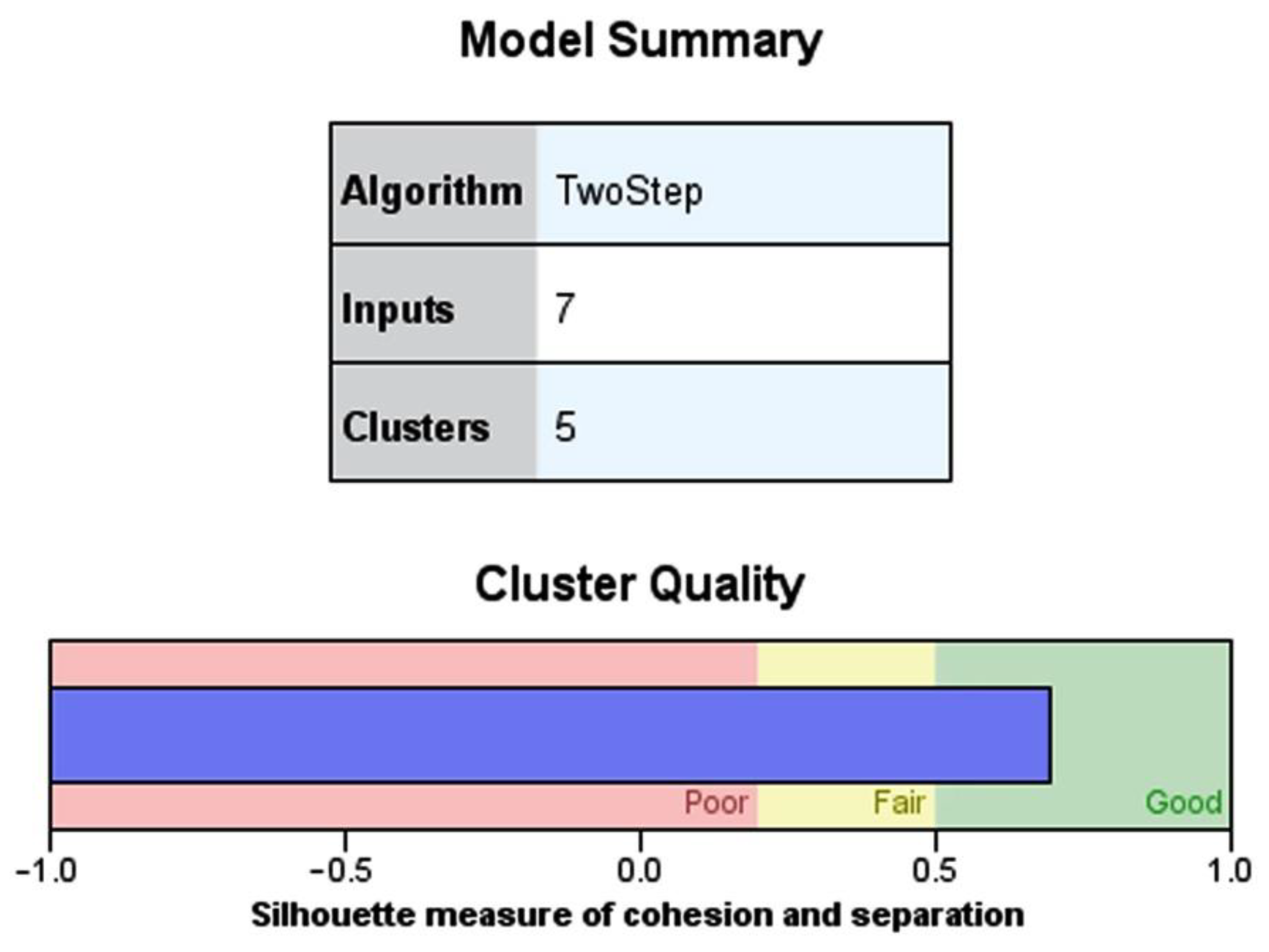
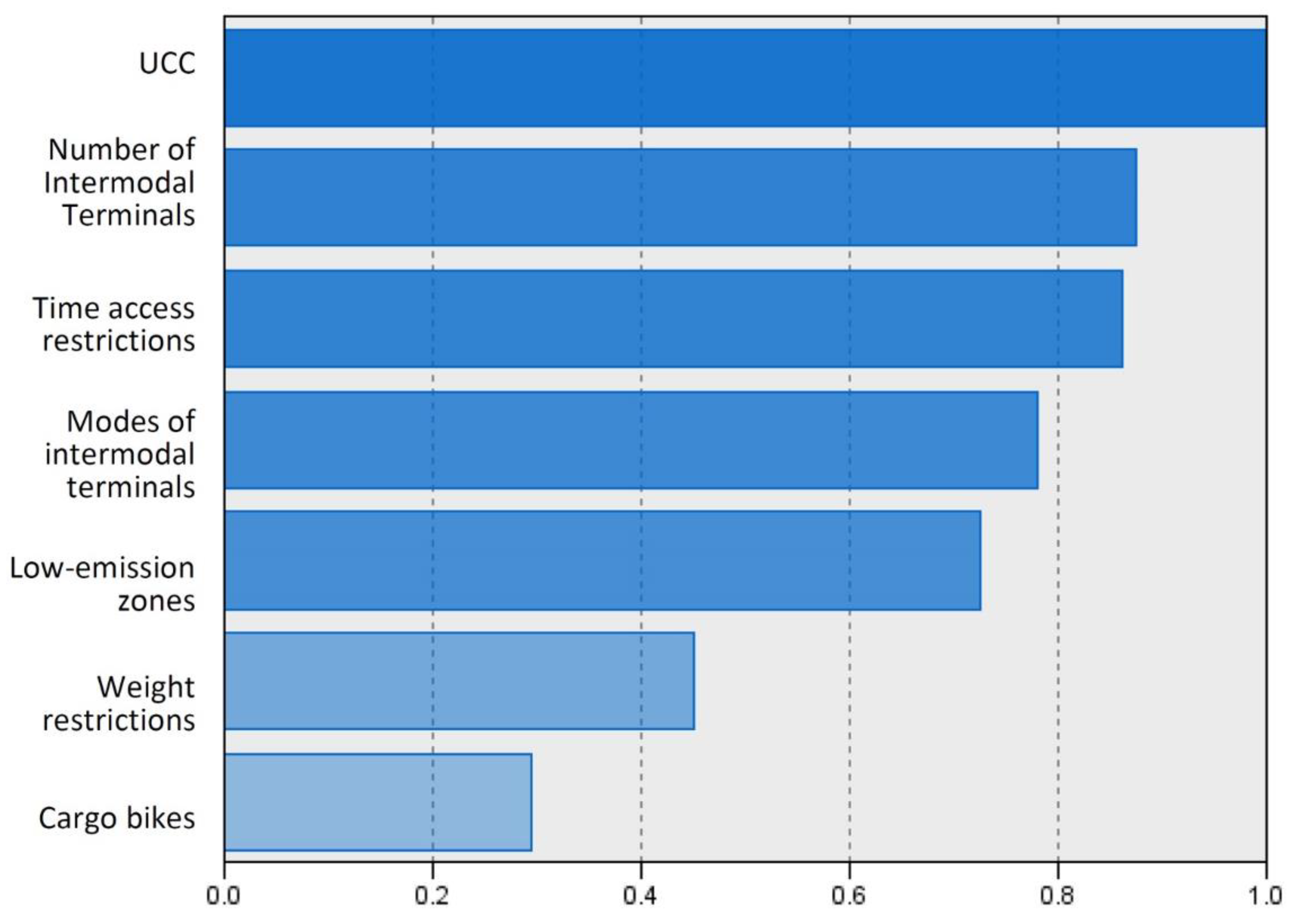

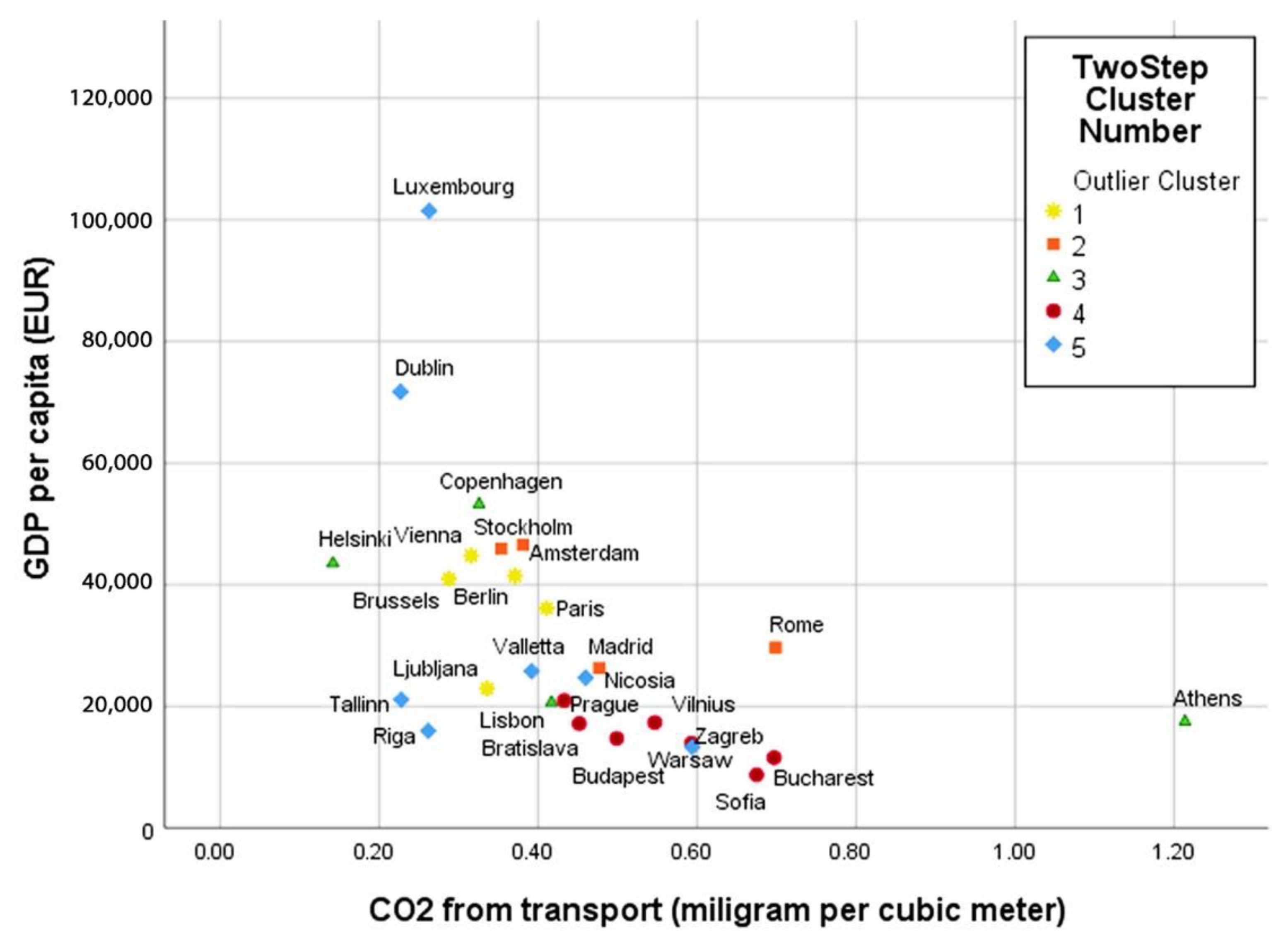
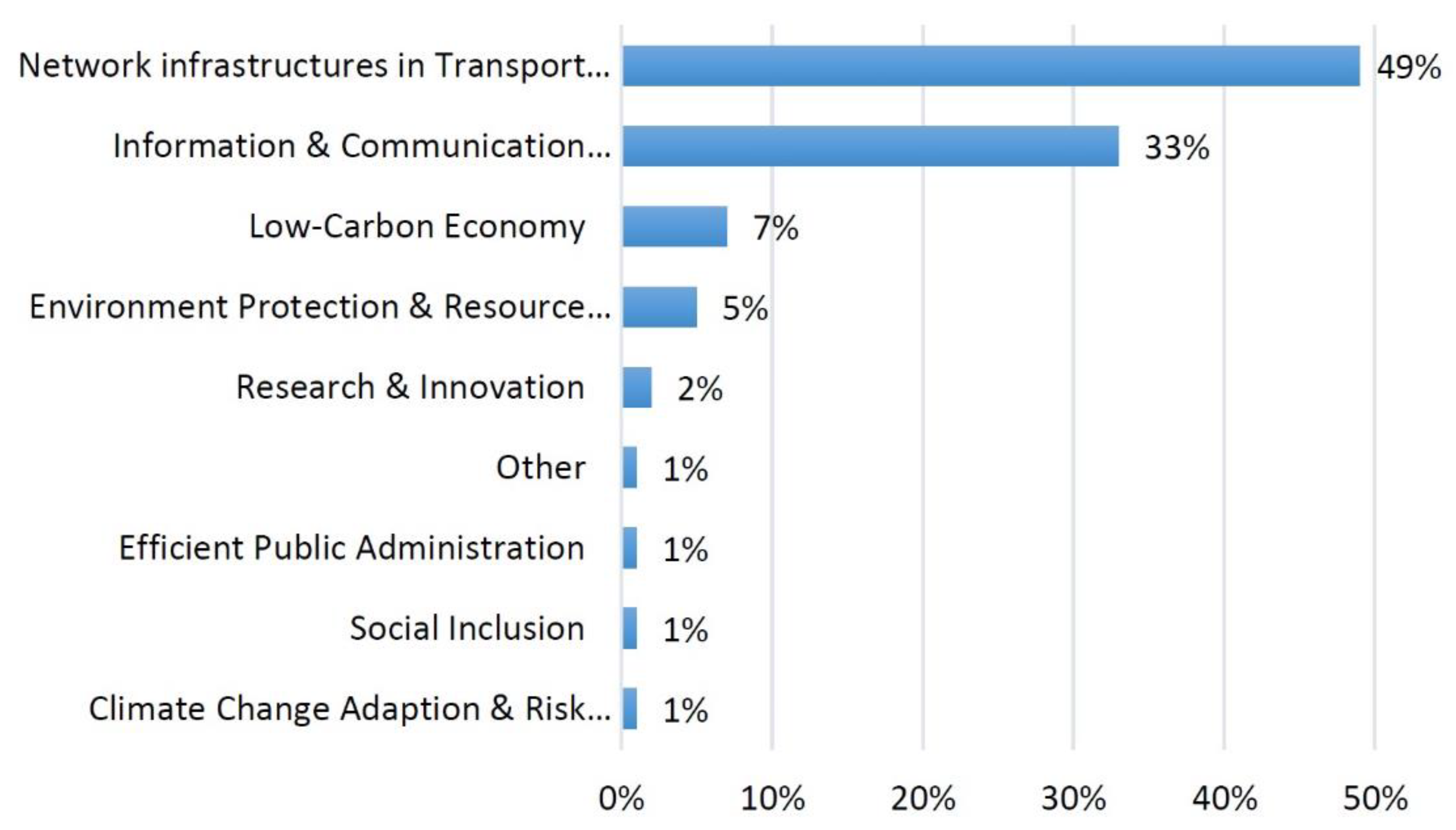
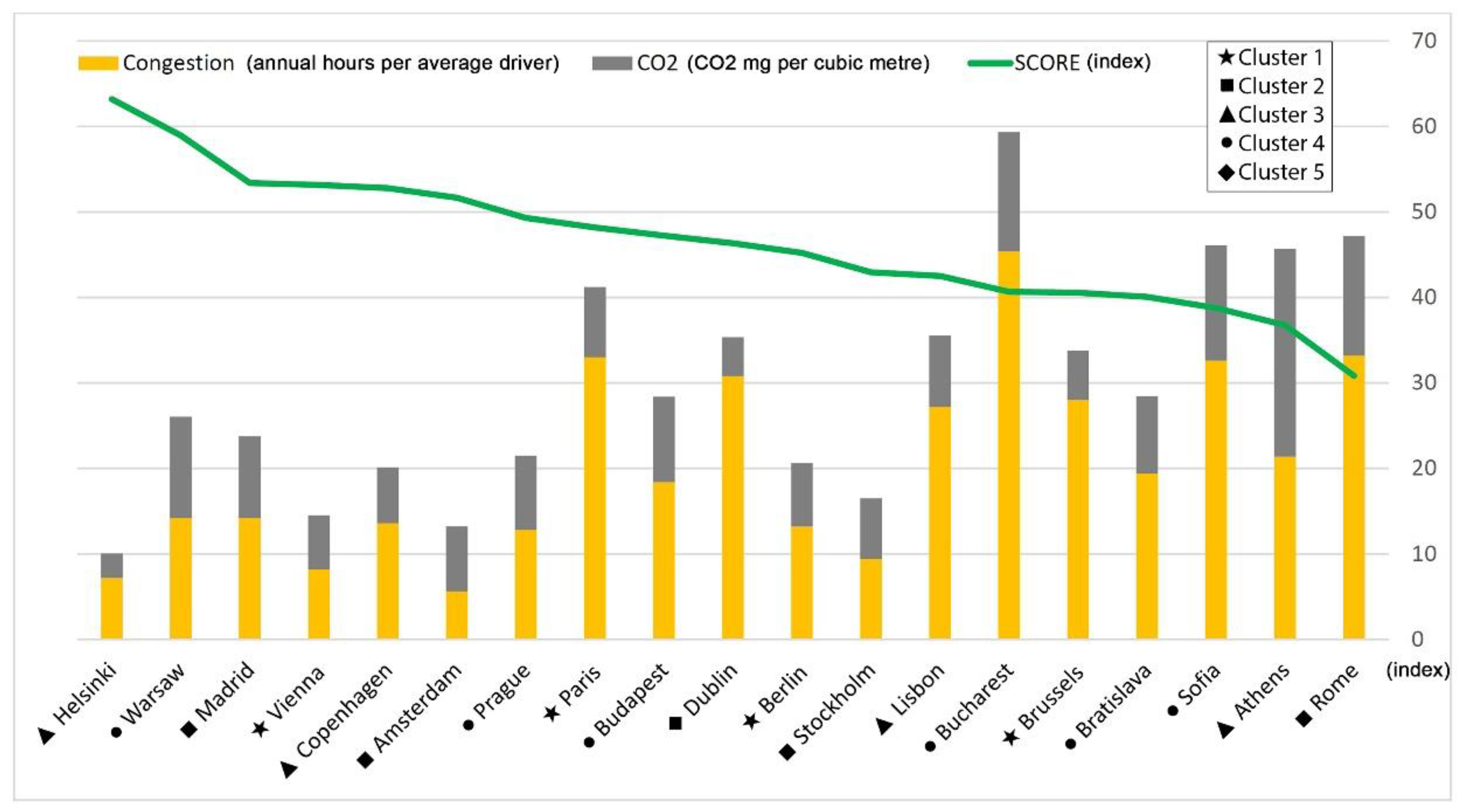
| Cluster | Size (n) | Representatives of the Cluster | % of Combined |
|---|---|---|---|
| 1 | 5 | Berlin, Brussels, Paris, Ljubljana, Vienna | 18.5% |
| 2 | 4 | Amsterdam, Madrid, Rome, Stockholm | 14.8% |
| 3 | 4 | Athens, Copenhagen, Helsinki, Lisbon | 14.8% |
| 4 | 7 | Bratislava, Bucharest, Budapest, Prague, Sofia, Vilnius, Warsaw | 25.9% |
| 5 | 7 | Dublin, Luxembourg, Nicosia, Riga, Tallinn, Valletta, Zagreb | 25.9% |
| Combined | 27 | 100% |
| Cluster | 1 (n = 5) | 2 (n = 4) | 3 (n = 4) | 4 (n = 7) | 5 (n = 7) |
|---|---|---|---|---|---|
| UCC (n) | 5 | 4 | 4 | 0 | 0 |
| Intermodal Term. (median n) | 2.2 | 0.5 | 0 | 2.14 | 0.43 |
| Time Access Restr. (n) | 4 | 4 | 0 | 7 | 0 |
| Modes of Intermodal Term. (n) | 5 (R-R-B) - | - 2 (R-R) | - - | 2 (R-R-B) 5 (R-R) | - 3 (R-R) |
| LEZ (n) | 4 | 4 | 3 | 0 | 0 |
| Weight Restr. (n) | 3 | 4 | 2 | 7 | 1 |
| Cargo Bikes (n) | 5 | 4 | 4 | 6 | 3 |
Publisher’s Note: MDPI stays neutral with regard to jurisdictional claims in published maps and institutional affiliations. |
© 2021 by the authors. Licensee MDPI, Basel, Switzerland. This article is an open access article distributed under the terms and conditions of the Creative Commons Attribution (CC BY) license (http://creativecommons.org/licenses/by/4.0/).
Share and Cite
Škultéty, F.; Beňová, D.; Gnap, J. City Logistics as an Imperative Smart City Mechanism: Scrutiny of Clustered EU27 Capitals. Sustainability 2021, 13, 3641. https://doi.org/10.3390/su13073641
Škultéty F, Beňová D, Gnap J. City Logistics as an Imperative Smart City Mechanism: Scrutiny of Clustered EU27 Capitals. Sustainability. 2021; 13(7):3641. https://doi.org/10.3390/su13073641
Chicago/Turabian StyleŠkultéty, Filip, Dominika Beňová, and Jozef Gnap. 2021. "City Logistics as an Imperative Smart City Mechanism: Scrutiny of Clustered EU27 Capitals" Sustainability 13, no. 7: 3641. https://doi.org/10.3390/su13073641
APA StyleŠkultéty, F., Beňová, D., & Gnap, J. (2021). City Logistics as an Imperative Smart City Mechanism: Scrutiny of Clustered EU27 Capitals. Sustainability, 13(7), 3641. https://doi.org/10.3390/su13073641








